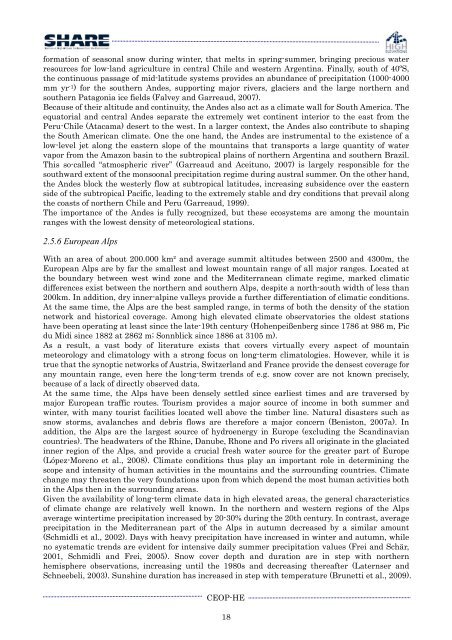here - CEOP-HE
here - CEOP-HE
here - CEOP-HE
You also want an ePaper? Increase the reach of your titles
YUMPU automatically turns print PDFs into web optimized ePapers that Google loves.
formation of seasonal snow during winter, that melts in spring-summer, bringing precious water<br />
resources for low-land agriculture in central Chile and western Argentina. Finally, south of 40ºS,<br />
the continuous passage of mid-latitude systems provides an abundance of precipitation (1000-4000<br />
mm yr -1 ) for the southern Andes, supporting major rivers, glaciers and the large northern and<br />
southern Patagonia ice fields (Falvey and Garreaud, 2007).<br />
Because of their altitude and continuity, the Andes also act as a climate wall for South America. The<br />
equatorial and central Andes separate the extremely wet continent interior to the east from the<br />
Peru-Chile (Atacama) desert to the west. In a larger context, the Andes also contribute to shaping<br />
the South American climate. One the one hand, the Andes are instrumental to the existence of a<br />
low-level jet along the eastern slope of the mountains that transports a large quantity of water<br />
vapor from the Amazon basin to the subtropical plains of northern Argentina and southern Brazil.<br />
This so-called “atmospheric river” (Garreaud and Aceituno, 2007) is largely responsible for the<br />
southward extent of the monsoonal precipitation regime during austral summer. On the other hand,<br />
the Andes block the westerly flow at subtropical latitudes, increasing subsidence over the eastern<br />
side of the subtropical Pacific, leading to the extremely stable and dry conditions that prevail along<br />
the coasts of northern Chile and Peru (Garreaud, 1999).<br />
The importance of the Andes is fully recognized, but these ecosystems are among the mountain<br />
ranges with the lowest density of meteorological stations.<br />
2.5.6 European Alps<br />
With an area of about 200.000 km² and average summit altitudes between 2500 and 4300m, the<br />
European Alps are by far the smallest and lowest mountain range of all major ranges. Located at<br />
the boundary between west wind zone and the Mediterranean climate regime, marked climatic<br />
differences exist between the northern and southern Alps, despite a north-south width of less than<br />
200km. In addition, dry inner-alpine valleys provide a further differentiation of climatic conditions.<br />
At the same time, the Alps are the best sampled range, in terms of both the density of the station<br />
network and historical coverage. Among high elevated climate observatories the oldest stations<br />
have been operating at least since the late-19th century (Hohenpeißenberg since 1786 at 986 m, Pic<br />
du Midi since 1882 at 2862 m; Sonnblick since 1886 at 3105 m).<br />
As a result, a vast body of literature exists that covers virtually every aspect of mountain<br />
meteorology and climatology with a strong focus on long-term climatologies. However, while it is<br />
true that the synoptic networks of Austria, Switzerland and France provide the densest coverage for<br />
any mountain range, even <strong>here</strong> the long-term trends of e.g. snow cover are not known precisely,<br />
because of a lack of directly observed data.<br />
At the same time, the Alps have been densely settled since earliest times and are traversed by<br />
major European traffic routes. Tourism provides a major source of income in both summer and<br />
winter, with many tourist facilities located well above the timber line. Natural disasters such as<br />
snow storms, avalanches and debris flows are t<strong>here</strong>fore a major concern (Beniston, 2007a). In<br />
addition, the Alps are the largest source of hydroenergy in Europe (excluding the Scandinavian<br />
countries). The headwaters of the Rhine, Danube, Rhone and Po rivers all originate in the glaciated<br />
inner region of the Alps, and provide a crucial fresh water source for the greater part of Europe<br />
(López-Moreno et al., 2008). Climate conditions thus play an important role in determining the<br />
scope and intensity of human activities in the mountains and the surrounding countries. Climate<br />
change may threaten the very foundations upon from which depend the most human activities both<br />
in the Alps then in the surrounding areas.<br />
Given the availability of long-term climate data in high elevated areas, the general characteristics<br />
of climate change are relatively well known. In the northern and western regions of the Alps<br />
average wintertime precipitation increased by 20-30% during the 20th century. In contrast, average<br />
precipitation in the Mediterranean part of the Alps in autumn decreased by a similar amount<br />
(Schmidli et al., 2002). Days with heavy precipitation have increased in winter and autumn, while<br />
no systematic trends are evident for intensive daily summer precipitation values (Frei and Schär,<br />
2001, Schmidli and Frei, 2005). Snow cover depth and duration are in step with northern<br />
hemisp<strong>here</strong> observations, increasing until the 1980s and decreasing t<strong>here</strong>after (Laternser and<br />
Schneebeli, 2003). Sunshine duration has increased in step with temperature (Brunetti et al., 2009).<br />
<strong>CEOP</strong>-<strong>HE</strong><br />
18


